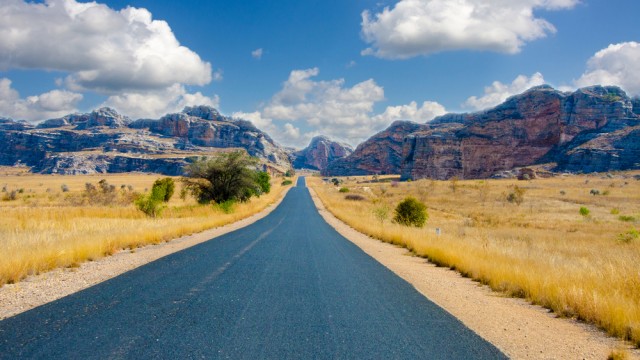Hot, weird and wild, southern Madagascar is filled with some of the world’s most exotic flora and surreal landscapes, with countryside resembling nowhere else on earth. The bustling port of Toliara is the region’s entry point and is worlds apart from the rural countryside. Bedecked in bougainvillea and jacaranda and filled with narrow corridors ripe with the smells of salty ocean water and fresh baguettes, there’s also hint of ethnic spiciness in the gritty feeling air. The wide boulevards here are home to both Arab and French architecture, with elaborate domed mosques sitting next to crumbling, whitewashed colonial buildings.
Day 1
Slightly grimy and definitely sweltering in the humid Tropic of Capricorn, Toliara is Southern Madagascar’s leading town. Central highlanders call it “The White City” because of the light-colored buildings. The views are outstanding as you approach the city. Vast sand dunes which run along the coast, stretch out before converging with the savanna, bush, and grassy plains. The sizzling, dusty town bustles with brightly painted pousse-pousses (rickshaws), refuse-strewn alleys, and disheveled architectural remnants from the French colonial facelift – all of which slip into heat-drenched languor between midday and 3 p.m.
The city has broad avenues flanked by tamarind and flame trees, sandy crowded alleys concealing narrow corridors and colonial-era buildings ending abruptly in a wall of rubble. This is the ending point for those travelling the Route de Sud (RN7), and you may very well end up spending a few days here waiting for transport elsewhere (remember: Mora Mora).
Upon arrival, note that most of the banks, hotels, markets and businesses are located along Boulevard Gallieni, which leads into the town center. From here, Avenue de France leads down past the post office to the port.
Begin your cultural immersion at the Musee Regional del l’Universite de Toliara, which underwent a recent renovation and features exhibits on local culture, an egg from the pre-historic elephant bird, aepyornis, along with other oddities and a freaky ancient mask with real human teeth.
Check into Hotel de Tulear, which is located down a small lane near the main taxi-brousse station. You’ll spend the night in a comfortable but basic bungalow in a garden. The property is also home to a bar and an excellent restaurant, Chez Alain. Have lunch here the first day. It is known for serving excellent French cooking, especially in the seafood department. Many patrons including locals choose to linger long into the evening, nursing whiskey at the al fresco bar.
Spend the afternoon on a tour with the hotel. Not only do they run a hotel and restaurant, they also have information on tours and activities in the area, rent mountain bikes and operate a dive center.
Another local guesthouse, Le Sax’Aphone is a good dinner option. Located in a lovely garden behind an iron gate, it serves a small menu which changes daily but usually includes some kind of pasta and fish. At night the proprietor often plays old jazz hits on the piano.
Finish up with a before-bed drink. La Bernique is one of a few popular hangouts in town and offers an extensive assortment of malt whiskies.
Day 2
Hire a taxi for the day, rent a motorcycle and explore outside the city, or travel like a local — hop onto a taxi-brousse. Head to Auberge de la Table, a private garden established by a Swiss botanist 12 kilometers southeast of Toliara, and just off the main road. It has close to 900 species of plants on site with 90 percent of them endemic to the region. It’s a must if you’re interested in the flora of Southern Madagascar. An English-speaking guide is included in the price. Have lunch after the tour at the onsite restaurant that specializes in goat cheese.
From the arboretum it’s just a few kilometer’s walk to St. Augustin where a group of English puritans first arrived to begin a new colony like the one in Virginia, U.S., in March 1645. The would-be colonizers were encouraged by reports of soil fertility and local goodwill towards foreigners. The soil proved unfruitful for the puritans and the locals weren’t as benign as reported — they had begun to equate foreigners with slavery. Disease and starvation took its toll, and only 12 of the original 140 settlers returned to England. For years, Baie St. Augustin, was a pirate haunt. Today, St. Augustin, with its little white church spire contrasting against the cliffs behind it, is no longer inhabited by pirates, but still retains an outlaw vibe. There’s a lagoon for swimming, and several good hikes from a village at what feels like the end of the world. Don’t skip the Grottos de Sarondrano, located 4 kilometers north of town. Here you’ll find two caves filled with fresh, translucent blue water. Nearby are springs and a natural swimming pool. Ask in the village for someone to show you the way.
For the second night in the region, arrange with Chez Alain to stay at their second property, La Mangrove, which is located about 10 kilometers from Toliara on the way to St. Augustin. There is no beach, but the jetty is a relaxing spot for sunset drinks and the property arranges meals with advance notice. There are also good walks in the area. You can spot lemurs in a nearby cave and boat trips can be arranged to Nosy Ve & Anakao, home to excellent diving and snorkeling. St. Augustin lies about 35 km south of Toliara along a good road and the two towns are connected Monday to Saturday by taxi-brousse.

